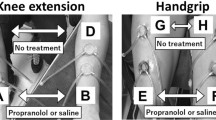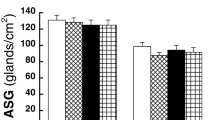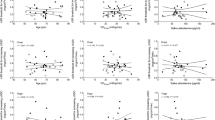Abstract
Purpose
Human eccrine sweat glands respond to α1-adrenergic receptor agonists. We recently reported that adrenergic mechanisms contribute to sweating in endurance-trained men during an incremental exercise to volitional fatigue. However, it remains unclear if this response is mediated by α1-adrenergic receptor activation.
Methods
Twelve endurance-trained men performed an incremental cycling bout until exhaustion while wearing a water-perfused suit to clamp skin temperature at ~ 34 °C. Bilateral forearm sweat rates were measured wherein the distal area was treated with either 1% terazosin (α1-adrenergic receptor antagonist) or saline solution on the opposite limb (Control) via transdermal iontophoresis. We also measured proximal bilateral forearm sweat rate in untreated sites to confirm that no between-limb differences in forearm sweat rate occurred. Once sweat rate returned to pre-exercise resting levels at ~ 20 min postexercise, 0.25% phenylephrine (α1-adrenergic receptor agonist) was iontophoretically administered to skin to verify α1-adrenergic receptor blockade.
Results
Sweat rates at the proximal untreated right and left forearm sites were similar during exercise (interaction, P = 0.581). Similarly, no effect of terazosin on sweat rate was measured relative to control site (interaction, P = 0.848). Postexercise administration of phenylephrine increased sweat rate at the control site (0.08 ± 0.09 mg cm−2 min−1), which was suppressed by ~ 90% at the terazosin-treated site (0.01 ± 0.02 mg cm−2 min−1) (P = 0.026), confirming that α1-adrenergic receptor blockade was intact.
Conclusion
Our findings demonstrate that α1-adrenergic receptors located at eccrine sweat glands do not contribute to eccrine sweating during incremental exercise in young endurance-trained men.


Similar content being viewed by others
Abbreviations
- ANOVA:
-
Analysis of variance
- HR:
-
Heart rate
- T co :
-
Core temperature
- T sk :
-
Mean skin temperature
- \(\dot{V}O_{2}\) :
-
Rate of oxygen consumption
- \(\dot{V}O_{{2{\text{peak}}}}\) :
-
Peak rate of oxygen consumption
References
Amano T, Koga S, Inoue Y, Nishiyasu T, Kondo N (2013) Characteristics of sweating responses and peripheral sweat gland function during passive heating in sprinters. Eur J Appl Physiol 113(8):2067–2075. https://doi.org/10.1007/s00421-013-2641-8
Amano T, Shitara Y, Fujii N, Inoue Y, Kondo N (2017) Evidence for β-adrenergic modulation of sweating during incremental exercise in habitually trained males. J Appl Physiol 123(1):182–189
Amano T, Fujii N, Inoue Y, Kondo N (2018a) Cutaneous adrenergic nerve blockade attenuates sweating during incremental exercise in habitually trained men. J Appl Physiol 125:1041–1050
Amano T, Igarashi A, Fujii N, Hiramatsu D, Inoue Y, Kondo N (2018b) β-Adrenergic receptor blockade does not modify non-thermal sweating during static exercise and following muscle ischemia in habitually trained individuals. Eur J Appl Physiol 118(12):2669–2677
Avila S, Buono MJ (2012) Priming of the sweat glands explains reflex sweating in the heat. Int J Hyperthermia 28(1):19–23. https://doi.org/10.3109/02656736.2011.613891
Buono MJ, Sjoholm NT (1988) Effect of physical training on peripheral sweat production. J Appl Physiol 65(2):811–814
Buono MJ, Tabor B, White A (2011) Localized beta-adrenergic receptor blockade does not affect sweating during exercise. Am J Physiol Regul Integr Comp Physiol 300(5):R1148–1151. https://doi.org/10.1152/ajpregu.00228.2010
Chemali KR, Gorodeski R, Chelimsky TC (2001) α-adrenergic supersensitivity of the sudomotor nerve in complex regional pain syndrome. Ann Neurol 49(4):453–459
Drummond P (1996) Adrenergic receptors in the forehead microcirculation. Clin Auton Res 6(1):23–27
Drummond PD (1997) The effect of adrenergic blockade on blushing and facial flushing. Psychophysiology 34(2):163–168
Drummond PD (2002) Prior iontophoresis of saline enhances vasoconstriction to phenylephrine and clonidine in the skin of the human forearm. Br J Clin Pharmacol 54(1):45–50
Drummond PD (2009) Alpha-1 adrenoceptor stimulation triggers axon-reflex vasodilatation in human skin. Auton Neurosci 151(2):159–163
Foster K, Weiner J (1970) Effects of cholinergic and adrenergic blocking agents on the activity of the eccrine sweat glands. J Physiol 210(4):883–895
Freund BJ, Joyner MJ, Jilka SM, Kalis J, Nittolo JM, Taylor JA, Peters H, Feese G, Wilmore JH (1987) Thermoregulation during prolonged exercise in heat: alterations with beta-adrenergic blockade. J Appl Physiol 63(3):930–936
Fujii N, McNeely BD, Kenny GP (2016) Nitric oxide synthase and cyclooxygenase modulate β-adrenergic cutaneous vasodilatation and sweating in young men. J Physiol 595(4):1173–1184
Gagnon D, Ganio MS, Lucas RA, Pearson J, Crandall CG (1985) Kenny GP (2012) Modified iodine-paper technique for the standardized determination of sweat gland activation. J Appl Physiol 112(8):1419–1425. https://doi.org/10.1152/japplphysiol.01508.2011
Haeusler G, Haefely W, Huerlimann A (1969) On the mechanism of the adrenergic nerve blocking action of bretylium. Naunyn-Schmiedeberg's Arch Pharmacol 265(3):260–277
Inoue Y, Ichinose-Kuwahara T, Funaki C, Ueda H, Tochihara Y, Kondo N (2014) Sex differences in acetylcholine-induced sweating responses due to physical training. J Physiol Anthropol 33(1):13. https://doi.org/10.1186/1880-6805-33-13
Kellogg D, Johnson J, Kosiba W (1989) Selective abolition of adrenergic vasoconstrictor responses in skin by local iontophoresis of bretylium. Am J Physiol Heart Circul Physiol 257(5):H1599–H1606
Kenefick RW, Cheuvront SN (2012) Hydration for recreational sport and physical activity. Nutr Rev 70(2):S137–S142
Kenefick RW, Cheuvront SN, Elliott LD, Ely BR, Sawka MN (2012) Biological and analytical variation of the human sweating response: implications for study design and analysis. Am J Physiol Regul Integr Comp Physiol 302(2):R252–258. https://doi.org/10.1152/ajpregu.00456.2011
Machado-Moreira CA, McLennan PL, Lillioja S, van Dijk W, Caldwell JN, Taylor NA (2012) The cholinergic blockade of both thermally and non-thermally induced human eccrine sweating. Exp Physiol 97(8):930–942. https://doi.org/10.1113/expphysiol.2012.065037
Mack GW, Shannon LM, Nadel ER (1986) Influence of beta-adrenergic blockade on the control of sweating in humans. J Appl Physiol 61(5):1701–1705
McGinn R, Paull G, Meade RD, Fujii N, Kenny GP (2014) Mechanisms underlying the postexercise baroreceptor-mediated suppression of heat loss. Physiol Rep 2(10):e12168
Morgan CJ, Friedmann PS, Church MK, Clough GF (2006) Cutaneous microdialysis as a novel means of continuously stimulating eccrine sweat glands in vivo. J Invest Dermatol 126(6):1220–1225. https://doi.org/10.1038/sj.jid.5700197
Ogawa T (1976) Effects of subcutaneously administered adrenaline on human eccrine sweating, with special reference to the physiological significance of the adrenergic sweating mechanism. Jpn J Physiol 26(5):517–528
Quinton P, Molyneux L, Ip W, Dupuis A, Avolio J, Tullis E, Conrad D, Shamsuddin A, Durie P, Gonska T (2012) β-adrenergic sweat secretion as a diagnostic test for cystic fibrosis. Am J Respir Crit Care Med 186(8):732–739
Ramanathan NL (1964) A new weighting system for mean surface temperature of the human body. J Appl Physiol 19:531–533
Sato K, Sato F (1981a) Pharmacologic responsiveness of isolated single eccrine sweat glands. Am J Physiol Regul Integr Comp Physiol 240(1):R44–R51
Sato K, Sato F (1981b) Role of calcium in cholinergic and adrenergic mechanisms of eccrine sweat secretion. Am J Physiol 241(3):C113–120
Sato K, Sato F (1983) Cholinergic potentiation of isoproterenol-induced cAMP level in sweat gland. Am J Physiol Cell Physiol 245(3):C189–C195
Sato K, Sato F (1984) Defective beta adrenergic response of cystic fibrosis sweat glands in vivo and in vitro. J Clin Invest 73(6):1763
Sawka MN, Burke LM, Eichner ER, Maughan RJ, Montain SJ, Stachenfeld NS (2007) American College of Sports Medicine position stand. Exercise and fluid replacement. Med Sci Sports Exerc 39(2):377–390
Shamsuddin A, Reddy M, Quinton P (2008) Iontophoretic β-adrenergic stimulation of human sweat glands: possible assay for cystic fibrosis transmembrane conductance regulator activity in vivo. Exp Physiol 93(8):969–981
Uno H (1977) Sympathetic innervation of the sweat glands and pilorrector muscles of macaques and human beings. J Invest Dermatol 69(1):112–120
Weihe E, Schütz B, Hartschuh W, Anlauf M, Schäfer MK, Eiden LE (2005) Coexpression of cholinergic and noradrenergic phenotypes in human and nonhuman autonomic nervous system. J Comp Neurol 492(3):370–379
Wilcox R, Bennett T, MacDonald I, Herbert M, Skene A (1984) The effects of acute or chronic ingestion of propranolol or metoprolol on the physiological responses to prolonged, submaximal exercise in hypertensive men. Br J Clin Pharmacol 17(3):273–281
Wingo JE, Low DA, Keller DM, Brothers RM, Shibasaki M, Crandall CG (2010) Skin blood flow and local temperature independently modify sweat rate during passive heat stress in humans. J Appl Physiol 109(5):1301–1306. https://doi.org/10.1152/japplphysiol.00646.2010
Acknowledgements
We thank our volunteer subjects for participating in this study. We would like thank Dr. Tomoyuki Yokoyama for the medical support provided.
Funding
This study was supported by a Grant-in-Aid for Scientific Research (No. 18H03146) from the Japan Society for the Promotion of Science from the Ministry of Education, Culture, Sports, Science, and Technology of Japan.
Author information
Authors and Affiliations
Contributions
Conception, design of research, data collection, and data analyses were undertaken by TA, the manuscript was drafted by TA, NF, and GPK and all authors (TA, NF, YI, and NK) contributed to data interpretation, editing and revision of manuscript, and approved the final version.
Corresponding author
Ethics declarations
Conflict of interest
The authors declare that they have no conflict of interest.
Additional information
Communicated by George Havenith.
Publisher's Note
Springer Nature remains neutral with regard to jurisdictional claims in published maps and institutional affiliations.
Rights and permissions
About this article
Cite this article
Amano, T., Fujii, N., Kenny, G.P. et al. Does α1-adrenergic receptor blockade modulate sweating during incremental exercise in young endurance-trained men?. Eur J Appl Physiol 120, 1123–1129 (2020). https://doi.org/10.1007/s00421-020-04351-3
Received:
Accepted:
Published:
Issue Date:
DOI: https://doi.org/10.1007/s00421-020-04351-3




